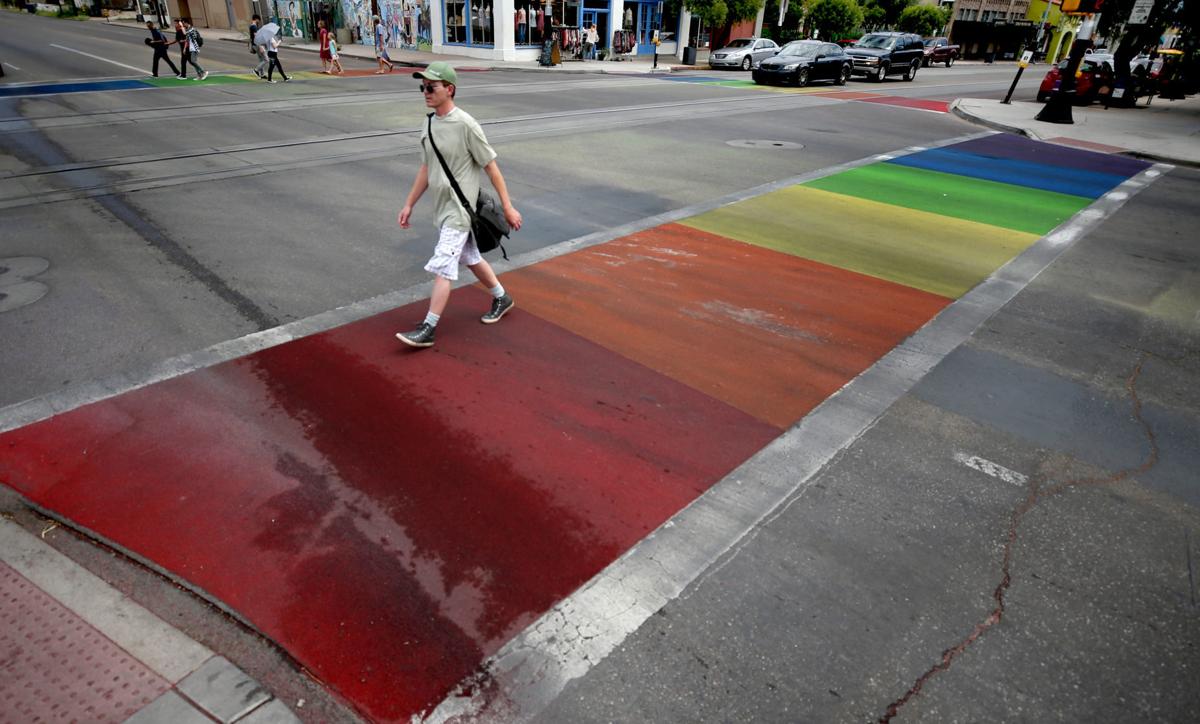It has been an eventful week for Arizona’s first-ever Rainbow Crosswalks, which now span the North Fourth Avenue-East Sixth Street intersection.
Before the dedication ceremony last week, a Styrofoam cup filled with white paint marred the eastern span across Sixth, though whether it was an act of vandalism is still under investigation by the Tucson Police Department, a spokesman said.
While those involved with the project say the balance of public opinion has been positive, social media has lit up with criticism that ranges from measured and taxpayer-focused to shrill and homophobic.
There have been a lot of questions about how much the project cost, and how much public money went into it. Those seemed like sensible questions for the Road Runner to dive into.
After putting in a handful of public records requests and speaking with a number of officials involved, $10,400 of Councilwoman Karin Uhlich’s unexpended office funds appears to be the public’s share. In May, the City Council approved spending up to $12,500 from those funds for “the materials needed to complete the Rainbow Crosswalk project.” Another $377.01 went into labor and materials to fix the damage caused by the dropped or tossed white paint, according to information provided by a city spokesman.
An invoice obtained by the Star — the only one officials expect to be covered by city dollars — says the 10 grand went toward the rainbow aggregate sidewalk, layout, surface preparation and installation of the materials.
In a statement, the Fourth Avenue Merchants Association, one of the project sponsors, said the cost was around $68,000. However, that calculation includes the estimated value of donated staff time, labor and additional materials beyond those covered by Uhlich’s office.
“It’s all in-kind,” said Fred Ronstadt, the association’s executive director.
Much of that came from Tucson-based Speedy Striping, which provided the labor and some of the materials free of charge, according to founder Lucas Boring.
“Every day we’re serving the public,” he said. “We just saw this as another opportunity to serve more of the public, a great community project.”
Adam Ragan, associate director of LGBTQ initiatives with the Southern Arizona AIDS Foundation, which first started promoting the idea of the crosswalks several years ago, described Boring as “an ally who has put in blood, sweat and tears to support our community, so therefore I consider that man family.”
The foundation, which also dedicated staff time to the crosswalks, was responsible for scheduling and administering the project, while the merchants association agreed to “take on the responsibility of ongoing maintenance,” according to two city documents.
On Friday morning, the Road Runner spoke with a number of pedestrians at the vibrant crossings, and the comments were almost exclusively positive.
Two teenage college students, home for the summer, said the public art project was a welcome change.
“I love it. I think it’s cool,” said University of California-Berkeley student Kat McLaughlin. “Where we go to college it’s the norm, and it’s nice it’s in our hometown. … It’s letting people know we’re an accepting community.”
“It’s a nice, progressive change for Tucson,” her friend, University of Washington student Aaliyah Ismail, said.
Avenue merchant Tank Ojha said the crosswalks add “a little flavor” on Fourth, and Tucsonan Hal von Bohnhoff took a smiling selfie in front of them after speaking with the Road Runner. Von Bohnhoff did note the crosswalks were looking a little “shabby” after less than a week of traffic.
Ricky Hart said he took no issue with the design or message of the project, but did raise a concern echoed numerous times on social media over the last week.
“To me there’s a lot of other things they could have done with the money,” he said. “That kind of money, they could have fixed the potholes with it.”
Uhlich concedes the money could have gone toward “a couple traffic bumps in a neighborhood, or a handful of bollards at the end of an alley somewhere,” but argued that the Rainbow Crosswalks are very much in keeping with how unspent ward office funds have been used historically: funding public art, community projects and neighborhood traffic mitigation.
In the case of crosswalks, Uhlich said they were both traffic safety measures and public art, which would have also cost significantly more if the city had undertaken them on its own.
“Any time we allocate public funds, we have to weigh what will have the greatest impact for limited dollars,” she added.
DOWN THE ROAD
Not much new road work to report, but there will be a meeting of the Pima County Transportation Advisory Committee on Monday afternoon, Aug. 14.
Among other things, that board is tasked with deciding what local road repair projects to prioritize with the proceeds of a recently approved $19.5 million road property tax.
Monday’s noon to 4 p.m. meeting at the Abrams Public Health Center will focus on projects proposed by Oro Valley. The address is 3950 S. Country Club Road.





